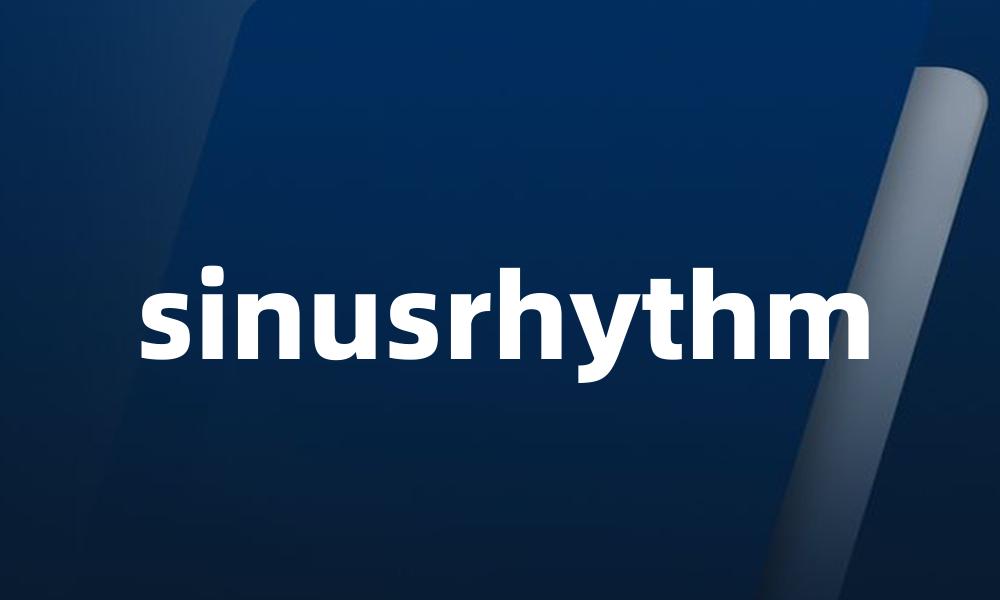
Sinusrhythm
Sinusrhythm 是一个医学术语,指的是一种正常的心脏节律,通常由窦房结产生,表示健康的心脏功能。这个词没有形容词和名词的不同含义,其主要用法集中在描述心脏的节律状态。
词语辨析
Sinusrhythm 主要用于医学领域,尤其在心脏病学中。与之相对的词是 arrhythmia,指的是心律失常,表现为心脏节律的异常。
词汇扩充
- Arrhythmia - 心律失常
- Bradycardia - 心动过缓
- Tachycardia - 心动过速
- Cardiac cycle - 心脏周期
近义词
- Normal heart rhythm - 正常心律
- Regular heartbeat - 有规律的心跳
反义词
- Arrhythmia - 心律失常
- Irrational heartbeat - 不规律心跳
词典参考
According to the Collins Dictionary, sinusrhythm is defined as the normal rhythm of the heart.
根据柯林斯词典,sinusrhythm 被定义为心脏的正常节律。
The Oxford Dictionary states that sinusrhythm is crucial for maintaining overall heart health.
牛津词典指出,sinusrhythm 对于维持整体心脏健康至关重要。
例句
The patient was diagnosed with sinusrhythm after the ECG showed no abnormalities.
经过心电图检查,患者被诊断为有窦性心律,没有异常。
A healthy sinusrhythm is important for effective blood circulation.
健康的窦性心律对有效的血液循环非常重要。
During the examination, the doctor noted the presence of sinusrhythm.
在检查过程中,医生注意到有窦性心律。
Patients with sinusrhythm typically have a heart rate of 60 to 100 beats per minute.
通常,具有窦性心律的患者每分钟心率为60到100次。
Any deviation from sinusrhythm can indicate a potential heart problem.
任何偏离窦性心律的情况都可能表明潜在的心脏问题。
Monitoring sinusrhythm is essential in critical care settings.
在重症护理环境中,监测窦性心律至关重要。
The presence of sinusrhythm is a positive sign in a cardiac assessment.
在心脏评估中,存在窦性心律是一个积极的信号。
Healthcare providers use tools to verify the presence of sinusrhythm.
医疗服务提供者使用工具来验证窦性心律的存在。
Children typically exhibit a stable sinusrhythm during routine check-ups.
儿童在常规检查中通常表现出稳定的窦性心律。
Patients recovering from surgery are monitored for sinusrhythm.
术后恢复的患者会被监测是否有窦性心律。
The nurse confirmed the patient's sinusrhythm before proceeding with treatment.
护士在进行治疗前确认了患者的窦性心律。
In elderly patients, maintaining sinusrhythm is particularly important.
在老年患者中,维持窦性心律尤其重要。
Electrocardiograms can easily detect sinusrhythm.
心电图可以轻松检测到窦性心律。
Doctors will often check for sinusrhythm during a physical examination.
医生在体检时通常会检查窦性心律。
Understanding sinusrhythm helps in diagnosing heart conditions.
了解窦性心律有助于诊断心脏病。
Patients with sinusrhythm generally have fewer complications.
通常具有窦性心律的患者并发症较少。
Restoring sinusrhythm is a primary goal in treating arrhythmias.
恢复窦性心律是治疗心律失常的主要目标。
It's crucial to distinguish between sinusrhythm and other types of rhythms.
区分窦性心律和其他类型的心律至关重要。
Patients often feel more secure knowing they have a sinusrhythm.
患者通常会感到更加安心,知道自己有窦性心律。

 小皮
小皮